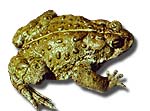(Western Toad)

Bufo
boreas
(Western Toad)

Key Characteristics:
|
Adult Characteristics |
Tadpole Characteristics |
Egg Characteristics |
|
Oval parotoid glands |
||
|
Horizontal pupil |
Double gel layer |
|
|
Light vertebral stripe |
Eyes don't extend |
Darkly pigmented |
| . | . | |
|
Bumpy skin |
. | . |
|
Squat body with |
. | . |
| . | . |
General
Description:
Western Toads
are roughly the same size as Woodhouse's Toads, ranging from 55
to 125mm (up to 5inches). They are also similar in that the females are
generally larger than the males. Western
Toads can be light tan, gray, greenish or brown
in dorsal coloration. They have a light colored (white or cream) vertebral stripe
running down their back. Ventrally, Western Toads usually have dark blotches
or mottling, on a light cream ground color. Western Toads lack cranial crests
and have oval shaped parotoid
glands![]() that aren't overly elongated (not more than twice as long as they are wide).
Other identifying characteristics are the lack of teeth in the upper jaw, a
horizontal pupil and the presence of two
tubercles on each of their hind feet.
that aren't overly elongated (not more than twice as long as they are wide).
Other identifying characteristics are the lack of teeth in the upper jaw, a
horizontal pupil and the presence of two
tubercles on each of their hind feet.
Western Toad tadpoles attain lengths up to around 25mm (1 in.) and are usually very dark in coloration. Their eyes are inset (when viewed from above). Often, Western Toad tadpoles are found swimming in large aggregations along the shallows of ponds and lakes.
Western Toad eggs are laid in a double-stranded string that may extend up to several meters in length. The eggs are darkly pigmented and have two gel layers (this helps distinguish them from Woodhouse's Toad eggs, which have a single gel layer).
Idaho
Distribution:
Western Toads are widely
distributed in Idaho and can be found in appropriate habitat throughout most
of the state.
Habitat:
Western Toads
are largely terrestrial but can generally be found within a fair proximity
to water. Their habitats range from mountain meadows to brushy desert flats.
Diet:
In Northwest, larvae filter
suspended plant material, or feed on bottom detritus![]() .
Adults eat all types of flying insects and spiders, crayfish, sowbugs, and earthworms.
.
Adults eat all types of flying insects and spiders, crayfish, sowbugs, and earthworms.
Ecology:
Digs burrow in loose soil or
uses burrows of small mammals. Activity varies seasonally and geographically.
At low elevations, individuals are mainly diurnal in late winter and spring,
and nocturnal in summer. Mountain populations are active day or night in summer,
depending on conditions. Hibernation![]() occurs in winter in cold climates. Birds and garter snakes prey on adults, and
predatory insect larvae feed on young. Western toads appear to be declining
in Greater Yellowstone Ecosystem and in other parts of western United States.
occurs in winter in cold climates. Birds and garter snakes prey on adults, and
predatory insect larvae feed on young. Western toads appear to be declining
in Greater Yellowstone Ecosystem and in other parts of western United States.
Reproduction:
Breeding period varies according
to conditions, but usually occurs from late January through July (in Snake River
Canyon, breeding occurs in early July as an adaptation to high levels of runoff
water). Females deposit an average of 12,000 eggs/clutch; eggs are laid in 2
strands. Larvae metamorphose in second summer in mountains, and in first summer
in other areas. Males do not have a mating call as do many frogs and other toads,
but they do vocalize and can be heard.
Conservation:
|
Status: |
Protected nongame species |
|
Global Rank: |
|
|
State Rank: |
S4 |
Important State
Reference:
Bartelt, P.E. and C.R. Peterson.
1994. Riparian habitat utilization by western toads (Bufo boreas) and
spotted frogs (Rana pretiosa). Final report to the USDA Forest Service
Inter. Res. Sta., Boise. 30pp.
Species description, key
characteristics and original work by John Cossel Jr. © 1997
Species ecological information from Groves et al. ©1997.
Original images provided by Charles R. Peterson, Edward Koch and Charlotte C.
Corkran,© 1997
Design and Optimization by Ean Harker©1999, 2000.
DAI layout by Stephen Burton, and Mike Legler © 1999.